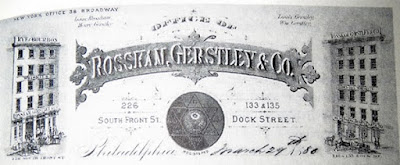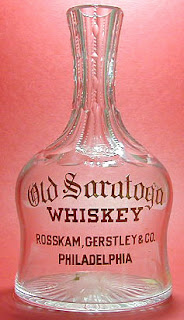 For many years I have been fascinated by pre-Prohibition back-of-the bar bottles (BoBBs). Gifted by distillers and liquor wholesalers to favored customers like saloons, hotels and restaurants, the bottles were among the most expensive liquor-related giveaways, often featuring fine glass and gold accents. BoBBs were expected to catch the eye of patrons — and did.
For many years I have been fascinated by pre-Prohibition back-of-the bar bottles (BoBBs). Gifted by distillers and liquor wholesalers to favored customers like saloons, hotels and restaurants, the bottles were among the most expensive liquor-related giveaways, often featuring fine glass and gold accents. BoBBs were expected to catch the eye of patrons — and did.
 In featuring these bottles it seems appropriate to highlight a wholesale liquor house that stood out for the variety and attractive bottles it issued — the Rosskam, Gerstley & Co. of Philadelphia. To my mind, the two proprietors were the “kings” of those collectibles.
In featuring these bottles it seems appropriate to highlight a wholesale liquor house that stood out for the variety and attractive bottles it issued — the Rosskam, Gerstley & Co. of Philadelphia. To my mind, the two proprietors were the “kings” of those collectibles.
 Isaac Rosskam and his wife’s brother, Henry Gerstley, both immigrants from Germany, settled in Philadelphia and in 1869 opened the doors of their establishment. The company initially was located at 336 North Third Street but within a year had moved to larger quarters at 402 North Third, where it would stay until 1876.” Their proprietary brands were “Old Saratoga,” “Monogram," and “Fine Old Whiskey.”
Isaac Rosskam and his wife’s brother, Henry Gerstley, both immigrants from Germany, settled in Philadelphia and in 1869 opened the doors of their establishment. The company initially was located at 336 North Third Street but within a year had moved to larger quarters at 402 North Third, where it would stay until 1876.” Their proprietary brands were “Old Saratoga,” “Monogram," and “Fine Old Whiskey.”
 Reflecting the rapid and impressive growth of its business volume, the partners that year moved to two new buildings. One was five stories at 226 S. Front Street that advertised “Rye & Bourbon Whiskies” on the storefront. The other at 133-135 Dock Street of six stories proclaimed “Old Rye Whiskies.” Both locations allowed the firm adequate space to undertake “rectifying,” that is, blending whiskey bought from multiple sources to achieve tastes determined to have broad public appeal
Reflecting the rapid and impressive growth of its business volume, the partners that year moved to two new buildings. One was five stories at 226 S. Front Street that advertised “Rye & Bourbon Whiskies” on the storefront. The other at 133-135 Dock Street of six stories proclaimed “Old Rye Whiskies.” Both locations allowed the firm adequate space to undertake “rectifying,” that is, blending whiskey bought from multiple sources to achieve tastes determined to have broad public appeal
 Because Philadelphia, and indeed the U.S., was loaded with distillers, rectifiers, and wholesalers, the partners had to combat stiff competition for the business of restaurants, bars and saloons to stock their liquor. They also had to appeal to members of the drinking public to request their brands from bartenders. One way of advertising was to provide giveaway items that contained the names of Rosskam & Gerstley products. Although the partners also gave away tip trays and shot glasses, they specialized in elegant back-of-the-bar bottles.
Because Philadelphia, and indeed the U.S., was loaded with distillers, rectifiers, and wholesalers, the partners had to combat stiff competition for the business of restaurants, bars and saloons to stock their liquor. They also had to appeal to members of the drinking public to request their brands from bartenders. One way of advertising was to provide giveaway items that contained the names of Rosskam & Gerstley products. Although the partners also gave away tip trays and shot glasses, they specialized in elegant back-of-the-bar bottles.
 Those included bottles in fancy molded glass with stoppers, ornate gold lettering, and in one case a metal or pewter body. Shapes varied from bulbous bases to ginger jar shapes to straight sided bottles. Lettering might be in script, squared-off letters or san serif, and colored black, gold or cobalt blue. I have counted at least 21 varieties of Rosskam, Gerstley & Co. bar bottles. Ten of them are illustrated throughout this post. No other distiller or whiskey house I have researched comes close in number or variety.
Those included bottles in fancy molded glass with stoppers, ornate gold lettering, and in one case a metal or pewter body. Shapes varied from bulbous bases to ginger jar shapes to straight sided bottles. Lettering might be in script, squared-off letters or san serif, and colored black, gold or cobalt blue. I have counted at least 21 varieties of Rosskam, Gerstley & Co. bar bottles. Ten of them are illustrated throughout this post. No other distiller or whiskey house I have researched comes close in number or variety.
 At the turn of the Century, things changed at the Philadelphia liquor house. In 1899, Henry Gerstley died at age 61 at his residence. As Rosskam aged he turned over the reins of management to his son. A 1900 Philadelphia business directory lists William Rosskam as president of the firm. In 1904 Isaac died, age about 70. Although the company continued to prosper for a time under William, eventually it was forced to shut down by the enactment of National Prohibition.
At the turn of the Century, things changed at the Philadelphia liquor house. In 1899, Henry Gerstley died at age 61 at his residence. As Rosskam aged he turned over the reins of management to his son. A 1900 Philadelphia business directory lists William Rosskam as president of the firm. In 1904 Isaac died, age about 70. Although the company continued to prosper for a time under William, eventually it was forced to shut down by the enactment of National Prohibition.
The banning of bar bottles after the end of Prohibition was the result of their having been used for purposes that neither Rosskam nor Gerstley would have approved. Bartenders had a tendency when “Old Saratoga” or another whiskey had been dispensed from its fancy bar bottle to refill it with an inferior brand and cheerfully pour it out to customers under false pretenses. Today bottles behind the bar must be the container in which the liquor was sold, carrying an original label and tax stamps.

There remains a treasure trove of back-of-the-bar bottles. They steadily grow older. No more will be made and I have seen little evidence of fakery. Most BoBBs can be bought for under $100. Attractive and displaying well, they are certain to accrue in desirability and value in the future.
Note: A previous whiskey man vignette on this website featured Isaac Rosscom, focusing on his personality and religious orientation. It may be found on this website at February 10, 2014.




No comments:
Post a Comment